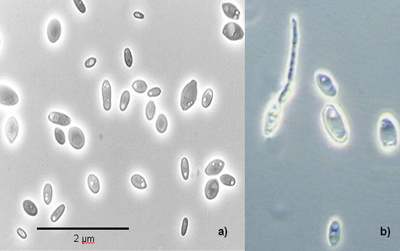Genus/species (aliases):
Dekkera anomala (Brettanomyces anomalus, anamorph, Brettanomyces/Dekkera claussensii, Torulopsis cylindrical, Candida beijingensis)
Classification:
Ascomycete, teleomorph
Cell Morphology:
 reproduction by budding; cells are spheroidal, subglobose to ellipsoidal, often ogival or cylindroidal to elongate. Average size is 2.0-5.5 by 3.0-22.0 um. Cells take many forms including single, pairs short chains and clusters. Pseudomycelium are branched, one celled, non-septate mycelium can sometimes be formed. Incomplete separation leads to some chains
reproduction by budding; cells are spheroidal, subglobose to ellipsoidal, often ogival or cylindroidal to elongate. Average size is 2.0-5.5 by 3.0-22.0 um. Cells take many forms including single, pairs short chains and clusters. Pseudomycelium are branched, one celled, non-septate mycelium can sometimes be formed. Incomplete separation leads to some chains
Colony Morphology:
Malt agar: White to cream, butyrous to membranous,
WL: colonies grow on WL + cyclohexamide agar.
Spore Morphology:
one to four hat-shaped or spheroidal with tangential brims ascospores; ascospores formation can take place on Difco malt agar after 3 weeks at 25oC but may be sparse.
Zygote: vegetative cells directly transformed into evanescent asci without a previous process of conjugation.
Ascus: arise without conjugation and are evanescent. Tendency of agglutination when released.
Liquid Growth:
Floccose to mucoid sediment can be formed. No Pellicle is formed.
Physiological Traits:
Fermentation:
Glucose, Galactose, Sucrose, Cellibose;
variable fermentation of: Maltose, Trehalose, Lactose, Melezitose
Assimilation:
Varies by strain: Galactose, Sucrose, Cellibose, Maltose, Trehalose, Lactose, Melezitose, Saliciin, Arbutrin, Glycerol, Gluconate, Lactate, Succinate, Ethanol;
variable use of nitrate and nitrite as N source; Variable use of Lysine, Ethylamine, Cadaverine, Tryptophan as sole N source; variable growth in vitamin-free medium, most strains require biotin and thiamin, some also require inositol.
Growth:
37 and 40oC variable
Growth sensitivities: resistant to cycloheximide; variable resistance to 1% acetic acid
Ethanol and acetic acid from glucose and acetaldehyde. Also vinyl phenols then convert them to ethyl phenols. 4-ethyl phenol and 4-guaiacol and iso valerica acid. Oxygen stimulates fermentation.
Ecological Traits: (where found in nature)
Found in wine, beer, soft drinks.
Distinguishing Features: (unique traits that can be used to identify organism)
Production of 4EP and 4EG. Growth on arginine with absolute requirement for biotin and thiamine.
Role in wine:
Imparts strong flavors and aromas in wine that are often described as horse blanket like, barnyard, band aid and fecal
Produce acetic acid in wine, to yield off flavors and aromas. Dekkera Anamola requires nutrients, and therefore can reduce vitamins and nutrients of a must.
Sensitivities:
- SO2: x
- Sorbate:
- DMDC:
- pH:
- Acids:
- Ethanol: up to 10%
- Anaerobiosis: x
- Heat:
References:
Edwards, C. 2005. Illustrated guide to microbes and sediments in Wine, Beer and Juice.
Kurtzman, C. and Fell, J. 1998. The Yeasts, A Taxonomic Study.
Tara Rakis 2010 UC DAvis VEN128 Wine Microbiology Course Submittal
